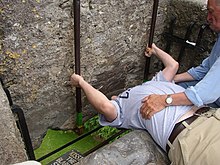Statue rubbing

Statue rubbing is the act of touching a part of a public statue. Popular among tourists, it is a form of superstition that is believed to bring good luck, ensure a return to the city, improve love life or make a wish come true.
The parts that are supposed to be rubbed are usually the most protruding or characteristic ones, for example noses or feet.[1] In Springfield, Illinois, at Lincoln's Tomb, rubbing the nose of Honest Abe's large bust is good luck.[2] Some of those superstitions also involve touching breasts or genitalia of the person depicted on the statue – this is usually supposed to bring luck in love or improve fertility. One example is the statue of Juliet in Verona.[2]
Rubbing statues can have negative effects on them as it causes erosion. Because of that some well-known statues had to be replaced with a replica[2] and some places discourage or ban tourists from doing it.[3][4] It is also possible to acquire a bacterial infection from touching statues.[5]
Notable examples
[edit]- Rubbing the testicles of the Charging Bull in New York for good luck[6]
- Rubbing the snout of the Porcellino statue in Florence and putting a coin in its mouth for good luck[7]
- Rubbing the breast of the Juliet statue in Verona to bring luck in love[8]
- Rubbing the crotch of the Monument of Victor Noir on the Pere Lachaise Cemetery, kissing his lips and leaving flowers in his hat to improve woman's love life and fertility[3]
- Rubbing or kissing the right foot of the Saint Peter statue in Vatican to have the prayers heard[9]
- Rubbing the arm of Everard t'Serclaes statue in Brussels, as well as the angel's face, the dog's face and the one of the shields to make a wish come true[10]
- Rubbing the left foot of the Timothy Eaton statue in Winnipeg to bring good luck[11]
- Rubbing the toes of the Statue of Margaret Thatcher and the Statue of Winston Churchill in the British Parliament.[12]
- Rubbing the nose on the Bust of Abraham Lincoln (Borglum) in front of the Lincoln Tomb to bring good luck
- Rubbing the nose of the badger outside the Governor's Office in the Wisconsin Capitol Building to bring good luck[13]
- Rubbing the nose of the statue of the loyal dog in Tolyatti by newlyweds to signify their "unbreakable fidelity".[citation needed]
Similarly rubbing the belly of any statue depicting Budai is said to bring good luck.[14] This custom might have originated from the Laughing Buddha statue in the Lingyin Temple.[15]
Similar rituals
[edit]
- Kissing the Blarney Stone in Blarney, Ireland to endow the kisser with the gift of the gab. Because of the location of the stone it can only be done while leaning backwards, usually with a help of an assistant.[16]
- Putting the hand inside Bocca della Verità mask in Rome which is said to work as a lie detector. Tourists make a statement while holding their hand inside the mask. If they told the truth, the hand comes unscathed, but if they lied, the mouth supposedly bites the hand off.[17]
- Standing on top of one of the mascarons near the entrance to the Franciscan Church in Dubrovnik, taking off the shirt and putting it back on while maintaining balance to bring luck in love.[18]
See also
[edit]References
[edit]- ^ "Statue Burnishing Etiquette". Roadside America. Archived from the original on 2 January 2017 – via Web Archive.
- ^ Jump up to: a b c Lakritz, Talia. "9 lucky monuments around the world that people flock to". Insider. Retrieved 2021-02-24.
- ^ Jump up to: a b "'Lewd rubbing' shuts Paris statue". BBC. 2 November 2004.
- ^ "Greyfriars Bobby's nose rubbing plea by Edinburgh officials". BBC. 31 October 2014.
- ^ Leigh Stewart (26 August 2019). "The bacteria on Europe's monuments: the results are in". Atlas Biomed.
- ^ "Tourists Love to Rub the Bronze Balls of Wall Street's Charging Bull Statue. Why?". Atlas Obscura. 19 January 2016.
- ^ "Porcellino Fountain in Florence". Visit Tuscany.
- ^ Sarah Sheffer (27 February 2014). "Veronas Juliet statue removed after continued damage by love-seeking tourists". PBS.
- ^ "Statue of St. Peter". St Peter's Basilica Info.
- ^ Nazlan Ertan (13 December 2008). "Wishing well, wishing wise". Hürriyet.
- ^ "MTS Centre / True North Sports & Entertainment Ltd". 2004-12-16. Archived from the original on 2004-12-16. Retrieved 2021-02-24.
- ^ "Do not touch Thatcher or Churchill statue feet, MPs told". BBC News. 2013-08-02. Retrieved 2021-08-17.
- ^ "Badger Sculpture of the USS Wisconsin". Atlas Obscura. Retrieved 2023-09-09.
- ^ Barbara O'Brien. "The Laughing Buddha". Learn Religions.
- ^ "The Luckiest Places in the World to Visit". 15 June 2018.
- ^ "Kiss The Blarney Stone". Blarney Castle.
- ^ "Mouth of truth". Rome.net.
- ^ "Jumping on the stone Dubrovnik". Dubrovnik Digest.
